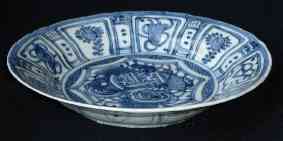The Kraak Porcelain Pattern
 |
Kraak porcelain was made in the Ming dynasty (1368-1644) and is one of
the earliest blue and white porcelain styles made for the European
market. Left: |
The name Kraak itself is a Dutch transcription of the Portuguese word
'Carraca', or 'Carrack' in English, a type of ship the Portuguese used
at the time. The word 'Kraak' appears to have been first used in the
seventeenth century by the Dutch and it is now the accepted name for
this pattern.
Kraak is predominantly known for its blue and white plates, dishes and
bowls. Although there do exist other items in lesser numbers, like
vases. Kraak tyoe porcelain was made in Jingdezhen and in Zhangzhou
(Zhangpu) and is basically an early type of export porcelain. There also
exists a rare green and red version of the Kraak wares, the color tone
of which is similar to the green and red Ming wares exported from
Jingdezhen and Zhangzhou (Zhangpu) to Japan. Kraak wares made in
Jingdezhen are generally of higher quality.
|
Basically, this pattern consists of a central medallion decoration, while the rim is divided into a number of sections with their own individual decorative content. A decoration is also present on the underside of the plate, although often somewhat simplified. |
 Above: |
While the Kraak pattern was made mainly during the Ming dynasty, it
continued to be manufactured into the early Qing dynasty. The latter is
recognizable from its better quality of the glaze. Usually, it also has
less kiln sand adhering to the bottom.
With Ming Kraak it is also normal that there are spots along the rim
edge where the clay is exposed by the white glaze.
See Kraak wares displayed by a museum collective in the Netherlands.
Chinese export wares with the Kraak design were mainly made from the
Ming dynasty (Wanli reign) until Qing dynasty. Exports ceased in the
18th century, possibly due to newer porcelain designs and techniques.
Care
must be used when identifying Kraak style porcelain; these wares were
extensively copied and reproduced in Japan until more recent times.
Return to China Patterns
From Kraak Porcelain to Swatow Wares
